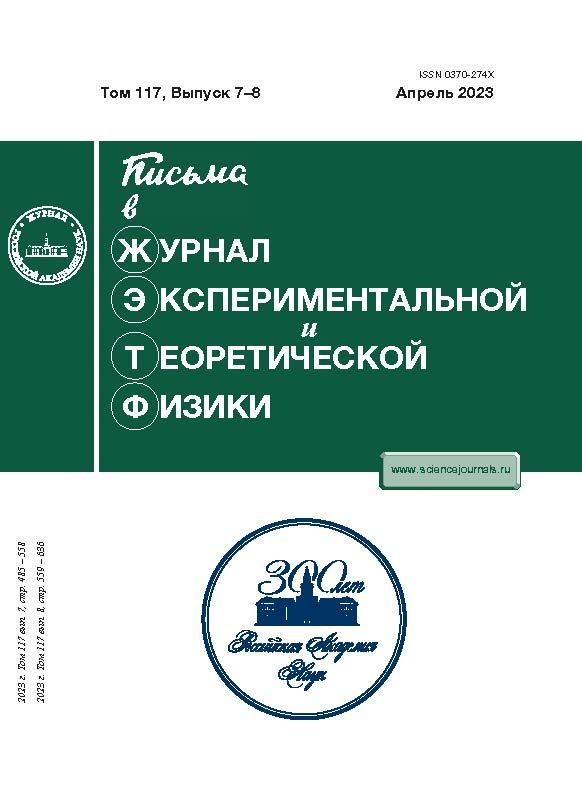Effect of Motion of Atoms on the Character of Subradiance of Cold Dilute Ensembles Excited by Resonant Pulsed Radiation
- Autores: Sokolov I.M1,2
-
Afiliações:
- Peter the Great St. Petersburg Polytechnic University, 195251, St. Petersburg, Russia
- Institute of Analytical Instrumentation, Russian Academy of Sciences, 190103, St. Petersburg, Russia
- Edição: Volume 117, Nº 7-8 (4) (2023)
- Páginas: 518-522
- Seção: Articles
- URL: https://rjeid.com/0370-274X/article/view/664126
- DOI: https://doi.org/10.31857/S1234567823070066
- EDN: https://elibrary.ru/JQMMEI
- ID: 664126
Citar
Texto integral
Resumo
The dynamics of the fluorescence of dilute atomic ensembles excited by resonant pulsed radiation has been analyzed. It has been found that the motion of atoms in ensembles cooled to sub-Doppler temperatures in certain time intervals noticeably enhances subradiance rather than suppressing it. It has also been shown that the time dependence of the spontaneous decay rate can be nonmonotonic. The revealed features occur because the character of the slow decay of the atomic excitation is determined after a certain time mainly by the dynamics of subradiant two-atom quantum states, which are due to the resonant dipole–dipole interaction between atoms.
Sobre autores
I. Sokolov
Peter the Great St. Petersburg Polytechnic University, 195251, St. Petersburg, Russia; Institute of Analytical Instrumentation, Russian Academy of Sciences, 190103, St. Petersburg, Russia
Autor responsável pela correspondência
Email: sokolov_im@spbstu.ru
Bibliografia
- L. L. Foldy, Phys. Rev. 67, 107 (1945).
- M. Lax, Rev. Mod. Phys. 23, 287 (1951).
- J. Javanainen, J. Ruostekoski, B. Vestergaard, and M.R. Francis, Phys. Rev. A 59, 649 (1999).
- M. Rusek, J. Mostowski, and A. Orlowski, Phys. Rev. A 61, 022704 (2000).
- F.A. Pinheiro, M. Rusek, A. Orlowski, and B.A. van Tiggelen, Phys. Rev. E 69, 026605 (2004).
- H. Fu and P.R. Berman, Phys. Rev. A 72, 022104 (2005).
- A.A. Svidzinsky, J. Chang, and M.O. Scully, Phys. Rev. A 81, 053821 (2010).
- Д.В. Кузнецов, Вл.К. Рерих, М. Г. Гладуш, ЖЭТФ 140, 742 (2011).
- T. Bienaim'e, R. Bachelard, P. W. Courteille, N. Piovella, and R. Kaiser, Fortschr. Phys. 61, 377 (2013).
- S.E. Skipetrov and I.M. Sokolov, Phys. Rev. Lett. 112, 023905 (2014).
- L. Bellando, A. Gero, E. Akkermans, and R. Kaiser, Phys. Rev. A 90, 063822 (2014).
- W. Guerin, M.O. Ara'ujo, and R. Kaiser, Phys. Rev. Lett. 116, 083601 (2016).
- A. S. Kuraptsev and I.M. Sokolov, Phys. Rev. A 94, 022511 (2016).
- W. Guerin, M.T. Rouabah, and R. Kaiser, J. Mod. Opt. 64, 895 (2017).
- A. S. Kuraptsev, I. Sokolov, and M.D. Havey, Phys. Rev. A 96, 023830 (2017).
- S.E. Skipetrov and I.M. Sokolov, Phys. Rev. B 99, 134201 (2019).
- И.М. Соколов, Д.В. Куприянов, М.Д. Хэви,ЖЭТФ 139, 288 (2011).
- J. Javanainen, J. Ruostekoski, Y. Li, and S.-M. Yoo, Phys. Rev. Lett. 112, 113603 (2014).
- S.D. Jenkins, J. Ruostekoski, S. Jennewein, R. Bourgain, J. Pellegrino, Y.R.P. Sortais, and A. Browaeys, Phys. Rev. A 94, 023842 (2016).
- T. Bienaime, N. Piovella, and R. Kaiser, Phys. Rev. Lett. 108, 123602 (2012).
- P. Weiss, A. Cipris, M.O. Ara'ujo, R. Kaiser, and W. Guerin, Phys. Rev. A 100, 033833 (2019).
- Y.A. Fofanov, I.M. Sokolov, R. Kaiser, and W. Guerin, Phys. Rev. A 1104, 023705 (2021).
- И.М. Соколов ЖЭТФ 159, 68 (2021).
- R.H. Dicke. Phys. Rev. 93, 99 (1954).
Arquivos suplementares










